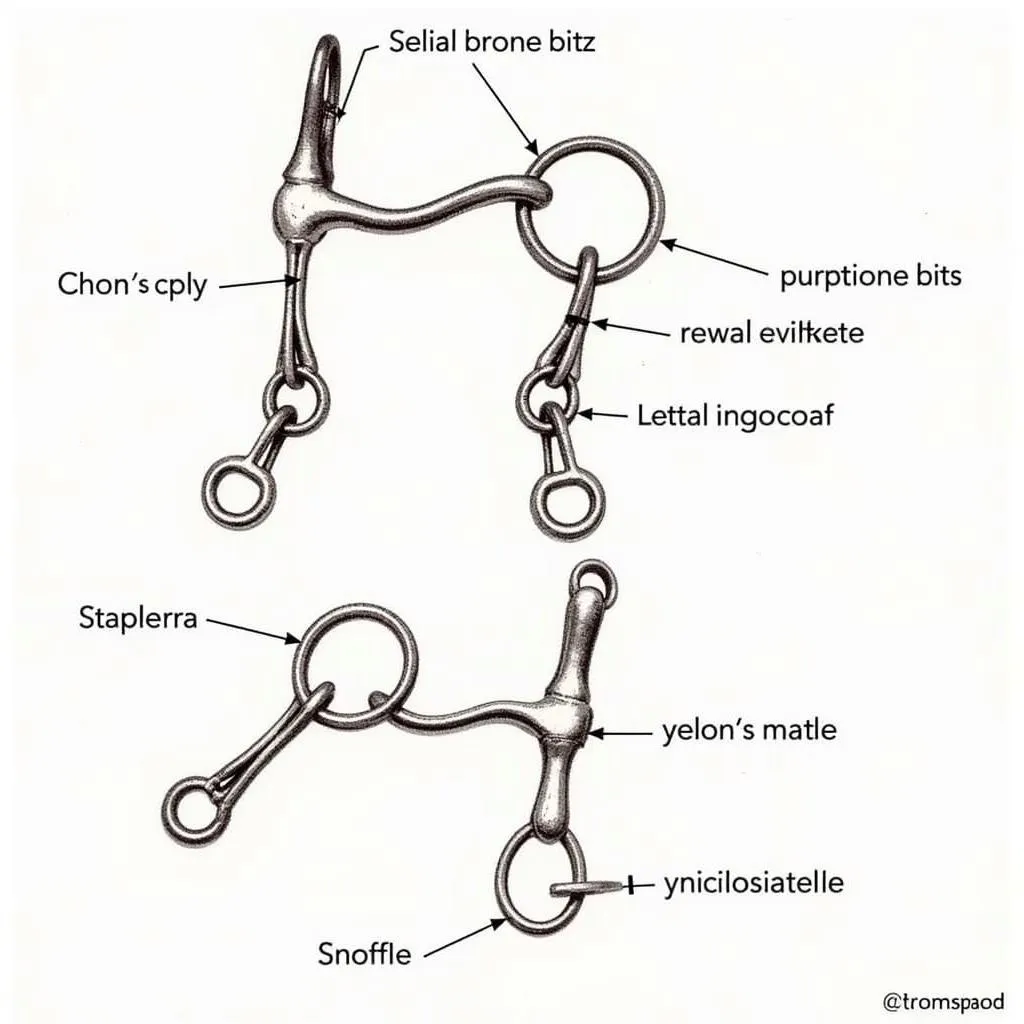“Bit in a horse’s mouth” is a common crossword puzzle clue. But have you ever stopped to think about what it actually means? A bit is more than just a piece of metal; it’s a crucial tool for communication between horse and rider. Understanding its purpose and how it influences a horse’s behavior is essential for any equestrian enthusiast.
Decoding the Language of Bits
Horses communicate primarily through body language. However, when we introduce riding, we need a way to convey our instructions. That’s where the bit comes in. This metal mouthpiece, resting on the horse’s bars (the sensitive area between their front and back teeth), works in conjunction with the reins to apply pressure. By varying the rein tension and direction, riders can signal a range of requests, from subtle changes in speed to intricate maneuvers.
Types of Bits: A World of Options
Just like there’s no one-size-fits-all approach to training, the world of bits offers a diverse range to suit different horses and riding disciplines.
- Snaffle Bits: Known for their mild action, snaffle bits are often used for young or inexperienced horses. They apply direct pressure on the tongue, bars, and corners of the mouth.
- Curb Bits: These bits feature shanks that create leverage, making them more powerful than snaffles. They are commonly used in Western riding and for horses requiring more guidance.
- Pelham Bits: Combining elements of both snaffle and curb bits, pelhams offer versatility and varying degrees of control depending on how they are adjusted.
 Different Horse Bits
Different Horse Bits
Choosing the right bit depends on factors like the horse’s age, temperament, training level, and the rider’s experience. A poorly fitted or inappropriate bit can cause discomfort, confusion, and even injury, hindering effective communication and compromising the horse’s well-being.
Beyond the Bit: The Importance of Soft Hands and Clear Signals
While the bit is a tool for communication, it’s crucial to remember that true horsemanship lies in understanding and responding to the horse’s needs. The bit should be used with a gentle touch, often referred to as “soft hands,” to avoid causing pain or distress.
Clear and consistent signals are paramount. Just like we learn to understand a new language, horses need time and patience to interpret our cues correctly. Harsh or inconsistent riding can lead to confusion, frustration, and a breakdown in communication.
 Horse and Rider Bond
Horse and Rider Bond
The Bit as a Reflection of Partnership
The “bit in a horse’s mouth” is more than just a crossword clue; it symbolizes the partnership between horse and rider. When used responsibly and with sensitivity, the bit becomes an extension of our intentions, allowing us to communicate with these magnificent creatures in a language they understand.
Remember, effective communication is a two-way street. By listening to our horses, understanding their individual needs, and using the bit as a tool for guidance rather than force, we can foster a relationship built on trust, respect, and mutual understanding.
FAQs about Bits and Horses
1. What are the signs of a bit that doesn’t fit properly?
Look for excessive head tossing, gaping at the mouth, rubbing the face against objects, or reluctance to accept the bit.
2. Can I change my horse’s bit on my own?
It’s always best to consult with an experienced equestrian professional before changing your horse’s bit. They can assess your horse’s needs and guide you towards the most suitable option.
3. Do all horses need to be ridden with a bit?
Not necessarily. Bitless riding, using equipment like hackamores or sidepulls, is becoming increasingly popular. These options rely on pressure points on the horse’s face rather than inside the mouth.
4. How often should I clean my horse’s bit?
Regular cleaning is essential for hygiene and to prevent rust. Ideally, clean the bit after every ride with warm water and a mild soap.
5. My horse is resistant to the bit. What should I do?
First, rule out any dental issues or pain by consulting with a veterinarian or equine dentist. If pain is ruled out, seek guidance from a qualified trainer to address potential training issues or discomfort related to the bit itself.
Exploring Further:
- Horseback Riding for Beginners: [Link to relevant article on Justus Horses USA]
- Choosing the Right Bit for Your Horse: [Link to relevant article on Justus Horses USA]
- Understanding Horse Body Language: [Link to relevant article on Justus Horses USA]
For any questions or assistance with your equestrian needs, don’t hesitate to contact us.
Phone: 0772127271
Email: [email protected]
Address: QGM2+WX2, Vị Trung, Vị Thuỷ, Hậu Giang, Việt Nam
Our dedicated team at Justus Horses USA is available 24/7 to support you and your equine partners.